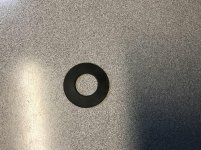Pete Wass
Well-known member
I watched a gentleman this past weekend tune his Heavy Varmint 30 Cal barrel EASILY with two stainless steel rings held together by friction, threaded onto the barrel. EASILY tuned that thick, heavy barrel with 4 Oz. This confirmed what I have suspected for a long time, most tuners do not need to be nearly as heavy as they are and there doesn't need to be anything exotic about them. A simple weight with a good graduated scale so that one knows where they are and where they are going and it doesn't take much movement to tune rifle barrels. Gene Beggs has it right, I believe.
I have noticed over the past couple of years lighter and lighter tuners appearing on Rimfire Rifles also. Harrels tuners turned down to what appears to be half their original weight. I have observed the same with Air Rifle barrels. It only takes an ounce to tune them, from my experience.
Pete
I have noticed over the past couple of years lighter and lighter tuners appearing on Rimfire Rifles also. Harrels tuners turned down to what appears to be half their original weight. I have observed the same with Air Rifle barrels. It only takes an ounce to tune them, from my experience.
Pete
Last edited:



